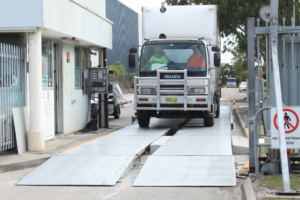Weighbridge come in different types and designs to suit different applications and site conditions. Some common types of weighbridges include:
Above ground weighbridge: This is the most common type of weighbridge, where the platform is mounted on a concrete foundation above the ground level. It is suitable for sites with good drainage and where the water table is not high.
Pitweigh inground weighbridge: This type of weighbridge is installed below ground level, with the platform level with the surrounding ground. It is suitable for sites with limited space and where the ground conditions are suitable for excavation.
Portable weighbridge: This type of weighbridge is designed for temporary or remote sites, where a permanent installation is not feasible. It can be easily transported and installed on a temporary site, and then removed when no longer needed.
Applications of weighbridges
Weighbridges have a wide range of applications in different industries, including:
Agriculture: Weighbridges are used to weigh agricultural products such as grain, hay, and livestock. Accurate weight measurements are important for trading and transportation purposes, as well as for tracking inventory and monitoring production.
Mining: Weighbridges are used to weigh minerals, ores, and other materials extracted from mines. Accurate weight measurements are important for trading and transportation purposes, as well as for monitoring production and ensuring compliance with safety and environmental regulations.
Logistics: Weighbridges are used to weigh trucks and trailers carrying goods and products for transportation. Accurate weight measurements are important for ensuring compliance with weight restrictions and regulations, as well as for preventing overloading, which can damage vehicles and roads.
Waste management: Weighbridges are used to weigh waste trucks and their contents. Accurate weight measurements are important for charging fees based on the weight of the waste, as well as for tracking waste disposal and recycling.
Construction: Weighbridges are used to weigh trucks carrying construction materials such as gravel, sand, and concrete. Accurate weight measurements are important for ensuring the right amount of materials are delivered to the construction site, as well as for tracking inventory and monitoring production.
Weighbridges are large scales used to weigh vehicles and their loads. They are an essential tool for industries that require accurate measurements of goods and products for trading, transportation, and processing purposes. In this article, we will discuss what weighbridges are, how they work, and their applications in different industries.
What is a weighbridge?
A weighbridge is a large scale used to weigh vehicles and their loads. It consists of a concrete platform mounted on load cells, which are sensors that measure the weight of the vehicle and its load. The load cells are connected to a digital weight indicator that displays the weight readings and records the data for future reference.
Weighbridges come in different sizes and capacities to accommodate various types of vehicles, from small cars to large trucks and trailers. They can be installed above ground or below ground, depending on the site conditions and the requirements of the application.
How does a weighbridge work?
To use a weighbridge, the vehicle is driven onto the platform and positioned within the marked area. The weight of the vehicle and its load is then recorded and displayed on the weight indicator. Once the weight is recorded, the vehicle can be driven off the platform, and the next vehicle can be weighed.
Weighbridges use load cells to measure the weight of the vehicle and its load. Load cells are electronic sensors that convert the weight of the vehicle and its load into an electrical signal. The electrical signal is then sent to the weight indicator, which displays the weight readings and records the data for future reference.
Advantages of using a weighbridge
Using a weighbridge has several advantages, including:
Accuracy: Weighbridges provide accurate weight measurements, which are essential for trading, transportation, and processing purposes.
Efficiency: Weighbridges can weigh vehicles and their loads quickly and efficiently, allowing for faster turnaround times and increased productivity.
Compliance: Weighbridges help to ensure compliance with weight restrictions and regulations, which can help to avoid fines and legal penalties.
Safety: Weighbridges help to prevent overloading, which can damage vehicles and roads, and can also pose a safety risk to drivers and other road users.
Data management: Weighbridges record weight data, which can be used for inventory tracking, production monitoring, and other data management purposes.
Maintenance and calibration
To ensure accurate weight measurements, weighbridges require regular maintenance and calibration. Maintenance involves checking and cleaning the load cells, as well as ensuring that the platform and foundation are in good condition. Calibration involves checking and adjusting the weight indicator to ensure that it is accurate.
Weighbridges should be serviced and calibrated by a qualified technician at least once a year, or more frequently if they are used heavily or in harsh environments.



